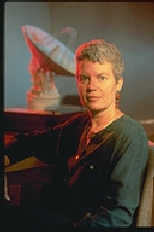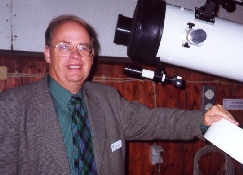 Jill Tarter (photo by Seth Shostak) |
 Ian Morison (photo by Dr Paul Shuch, SETI League) |

 Jill Tarter (photo by Seth Shostak) |
 Ian Morison (photo by Dr Paul Shuch, SETI League) |
Jill Tarter:If I didn't I wouldn't be spending a professional career trying to find it. That having been said, what I personally believe doesn't matter - what is crucial is evidence, and that's what we are trying to find.
Ian Morison:
The Universe contains countless billions of stars like our Sun - many of which will have planetary systems. If intelligent life can evolve here I can see no reason why it could not do so elswhere. I believe that other intelligent lifeforms will be commonplace. But these may well be spread thinly amongst the galaxies in which case there may not be many other civilisations in our own Galaxy - the Milky Way.
Jill Tarter:As Phil Morrison and Guiseppe Cocconi said in the first SETI article in scientific journal in 1959, it is difficult to estimate the chance of success, but if we don't search, the chance of success is zero. There is really no apriori way of knowing - everything is just guesses.
Ian Morison:
The present searches are only sensitive enough to realistically detect other civilisations within a relativly small distance across the Galaxy. They would have to be very widespread for us to have a good chance of receiving any communication from them, and this presupposes that they would want to do so! So I am not too optimistic but if you don't try how will you ever know?
Jill Tarter:Understanding our place in the cosmos is the next step in the Copernican revolution. We may eventually conclude that we are the only technological civilization in the Milky Way Galaxy, and so we have a right to hold onto our "top of the heap" view of ourselves. I personally doubt that this is so, and if we detect another civilization, its members will be so vastly different from us that the discovery will trivialize the distinctions among humans that today leads us to hatred and violence.
Ian Morison:
It is likely that any civilisation with whom we came into contact would have been in existance for thousands or millions of years - if so it would give our own human race optimism that we too can look forwards to the future. If after many years of searching we do not make any contact then it could mean that civilisations like ours are rare and we should do our best to nuture ourselves.
Jill Tarter:Carl Sagan wrote a book and Warner Brothers made a movie about a woman who does what I do. I've experienced much of what Ellie Arroway did, including the death of my father when I was young and the termination of government funding - unfortunately I have not yet detected a signal.
Jill TarterWe have been commercially broadcasting radio in the US since 1920 and TV since 1940. An advanced technology within 78 light years of earth may have heard that leakage radiation. The most easily detectable signals would be the carriers that identify the different stations. The modulation that represents the information content would be much harder to detect, and interpretation would be even harder because we didn't intend the programs to be understood by anybody except other humans.
Ian Morison:
If within around 50 light years of us they could, given sufficiently large antenna arrays, have detected the "leakage radiation " from the Earth such as Radars and TV signals. But the TV signals would be too weak for them to produce images. The use of arrays of optical telesocpes in space might enable them to observe the planets of our Solar System and detect the presence of Ozone in our atmosphere. This would tell them that our atmosphere contains Oxygen which would indicate to them that some lifeforms are present on the Earth.
Jill Tarter:Too close. We don't put much power into our TV or radio transmissions because their intended audience is not very far away. Our defense radars are much stronger and the current Phoenix search could detect that kind of signal out to the limit of our current search which is 155 light years. The strongest signal generated by our technology is the planetary radar on the Arecibo radio telescope and we could detect its signal half way to the center of the galaxy. The types of signals we look for are those that have their power concentrated into a very narrow band of frequencies - more compressed in frequency than anything that nature is capable of doing. We take this monochromatic (single frequency) signature as being evidence of technology.
Ian Morison:
Powerfull TV transmitters are probably a very short term requirement of a civilisation - already here they are being replace by Cable Transmission and relativly low power signals beamed down to Earth from satellites. Other civilisations, most likely far more advanced as ours, would almost certainly not "leak" radio signals as we do. But if they chose to set up a beacon as strong as the Planetary Radar at Arecibo in Puerto Rica pointed towards us we could detect it from a distance of tens of thousands of light years - but remember that the further away they are the longer ago they would have had to send the signal.
Jill Tarter:By using the Lovell telescope simultaneously with Arecibo, we can listen for very faint signals and discriminate against those that are produced by our own technology - radio frequency interference.
Ian Morison:
In use with the 305 m Arecibo Telescope it will produce the most sensitive system that we have yet used to detect extratrestrial signals and will have the ability to reject interference signals from the earth or from artificial satellites.
Jill Tarter:Ours is the only SETI project to observe with two widely spaced telescopes simultaneously. The motion of earth through space imparts a signature to an ET signal detected at the two sites that is different from the Doppler signature of a spacecraft or airplane and something like a mobile phone will be detected at only one of the sites. We swallow a broad piece of the spectrum and then chop it up into tens of millions of narrowband channel, each only 1 Hz wide, and we look for patterns in frequency and time that indicate that a continuous or pulsed signal is present.
Jill Tarter:Our observing targets are 1000 nearby stars like our own Sun. When we have a measurement of the stars age, we exclude those that are younger than about 3 billion years, so that if evolution elsewhere takes as long as it did here, there is the chance that technology will be present.
Ian Morison:
Project Phoenix is observing around a thousand Sun-like stars. These live long enough and provide enough heat to allow life a chance to evolve.
Jill Tarter:This is the oldest unanswered question of the human species - I can't imagine anything more important than trying to do an experiment that might answer the question. We happen to live in the first era that can try the experiment.
Jill Tarter:To date nobody has found any repeatable, verifiable signal from ETI, although everyone has found signals. Our computers are now getting fast enough to allow us to do the signal processing in real time and to follow up on any signals we find, to see if they are actually coming from a distant star or are just our own interference. We may have to explore millions or billions of stars before we succeed, we may even have to build our telescopes on the far side of the moon to avoid terrestrial interference before we succeed. We just have to take things one step at at a time and do the best search that technolgy allows.

|
Return to the NRAL / Jodrell Bank Home page |